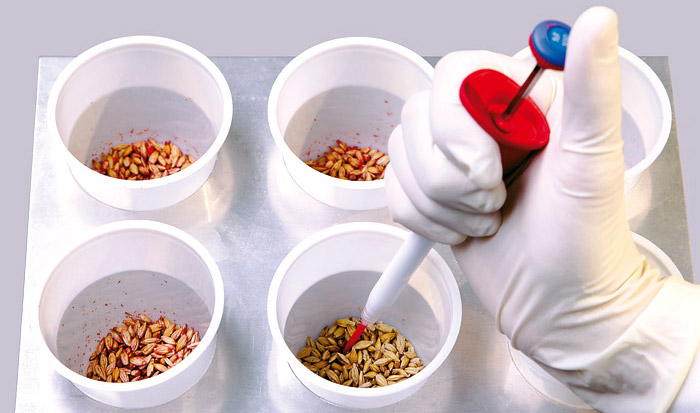Seed Treatment: A boon for agriculture
Every seed that is planted holds the promise of yield and harvest. However, seeds are also prone to various diseases, pests and other threats that can compromise their ability to germinate and grow into healthy plants. Seed treatment helps address these risks by protecting the seed right at the onset. It has emerged as an effective way to manage diseases and boost crop yields.
Reasons for Seed Treatment
Seeds are vulnerable to soil-borne pathogens and insects from the time they are planted in the field until the seedling emerges from the soil. Some common threats include seed-borne diseases like fungal infections, bacterial diseases, nematodes, and attacks from soil insects. Left unchecked, these can reduce germination rates and stunt early growth.
Seed Treatment helps control such problems in a few key ways. Coated chemicals on the seed surface prevent pathogen infection even before the seed germinates. Insecticides in the coating ward off damage from soil-dwelling insects. Fungicides, bactericides and other actives work to shield the seed and very young seedling from disease pressure. All of this gives the seed a healthy uninterrupted start.
Importance of Seed Protection
A successful stand establishment with uniform plant population is vital for high yields. Even a small reduction in plant counts due to poor germination can dent output. Seed treatment safeguards against stand losses caused by seed- and soil-borne pest pressure.
Higher germination rates allow optimal plant spacing in the field for efficient resource utilization. Timely establishment of crop canopy also helps compete against weeds. Early season protection transltes to vigorous seedling growth and development. Healthier plants from the onset are better able to optimize their genetic yield potential.
Types of Seed Treatment Technologies
Different types of seed treatment formulations and application methods are available to suit diverse crop needs:
– Seed Coating: This involves applying dry powder or slurry formulations containing actives using dedicated seed treatment equipment. The coating forms a protective film around the seed.
– Slurry/Slurrying: Wettable powder actives are mixed with water or other carriers to form a liquid slurry which is applied to seeds. The slurry adheres evenly to seed surfaces.
– Dusting/Dry Powder Application: Fungicides in powder form are directly dusted and mixed with seeds for surface application.
– Seed Pelleting/Pelletization: Seeds are encased within inert materials to form granular pellets. Actives are premixed within the pellets.
The seed treatment method and chemistry is chosen based on the target pests, crop type as well as factors like soil conditions and climatic zones.
Benefits of Seed Treatment
Reduced Disease Pressure
Coated fungicides and bactericides on seeds shield them from soil- and seed-borne pathogens. This curbs early disease infestation and establishment. Some diseases like seed rots and damping-off caused by fungi Pythium and Rhizoctonia are especially well controlled.
Insect Protection
Insecticides in coatings provide seeds initial protection from common soil pests like wireworms, white grubs, aphids and nematodes. This reduces chances of seed and seedling damage from chewing and sucking insects.
Higher Germination
By managing biotic stresses, seed treatment leads to more uniform and higher final stand establishment compared to untreated seeds. This enhances germination percentages under diverse field conditions.
Early Vigor Improvement
Healthy seedling growth is possible as coatings safeguard young plants in their most vulnerable early growth stages. Better root development and top growth translates to strong, competitive plants.
Positive Yield Impact
Timely stand establishment coupled with less early season stress equates to improved yields since the crop’s yield potential can be better optimized. On an average, seed treatment increases yields by 3-5% across major crops.
Economic Advantage
Higher yields due to better management of diseases and insects offsets the minimal input cost of seed treatment. Timely control also reduces need for curative sprays/application later in the season.
Popular Seed Treatment Products
Leading Crop Protection companies have developed top-class seed treatment formulations tailored for different crop needs:
– Syngenta: – Maxim XL, Celest XL, Actino WT, Vibrance Duo
– BASF: – Poncho, Opera, Phoenix
– Bayer: – Apron Maxx, Celebrate, Abound
– Sumitomo: – Concep, Elemax, Screen
– UPL: – Divida, Celebrate, Cartun
These product portfolios comprise fungicide, insecticide and nematicide active ingredients for protection against soil borne and seed borne pathogens & pests. Seed treatments have become a standard practice worldwide to boost sustainable agriculture.
The practice of seed treatment has revolutionized modern crop production systems. By safeguarding seeds right at the beginning, it helps deliver healthy, productive stands. Small upfront investment reaps good returns through higher yields. Seed treatment ensures optimized agronomic management throughout the crop cycle for maximizing profits. As threats evolve, continued research expands available solutions to usher agricultural progress.
*Note:
1. Source: Coherent Market Insights, Public sources, Desk research
2. We have leveraged AI tools to mine information and compile it




